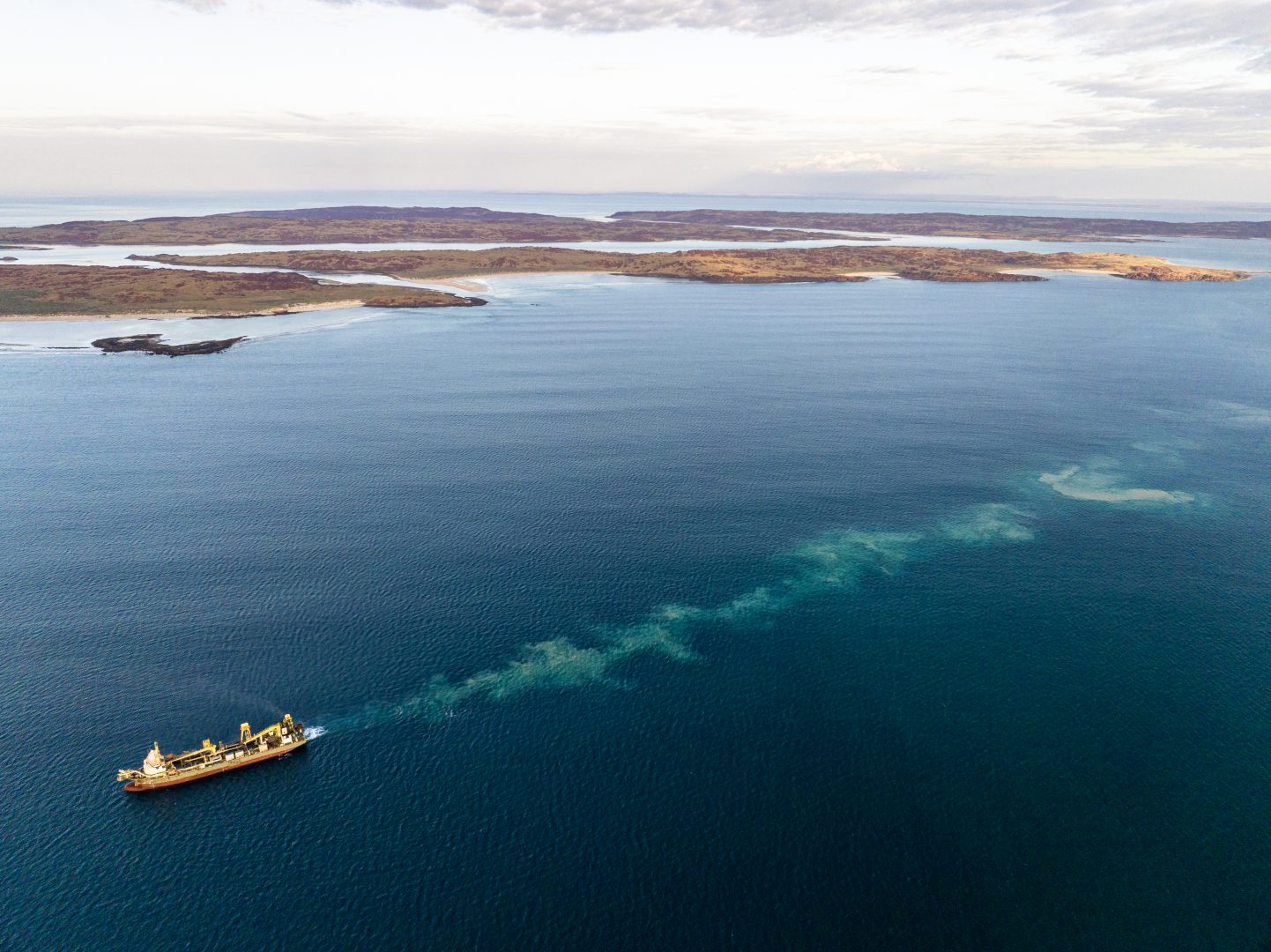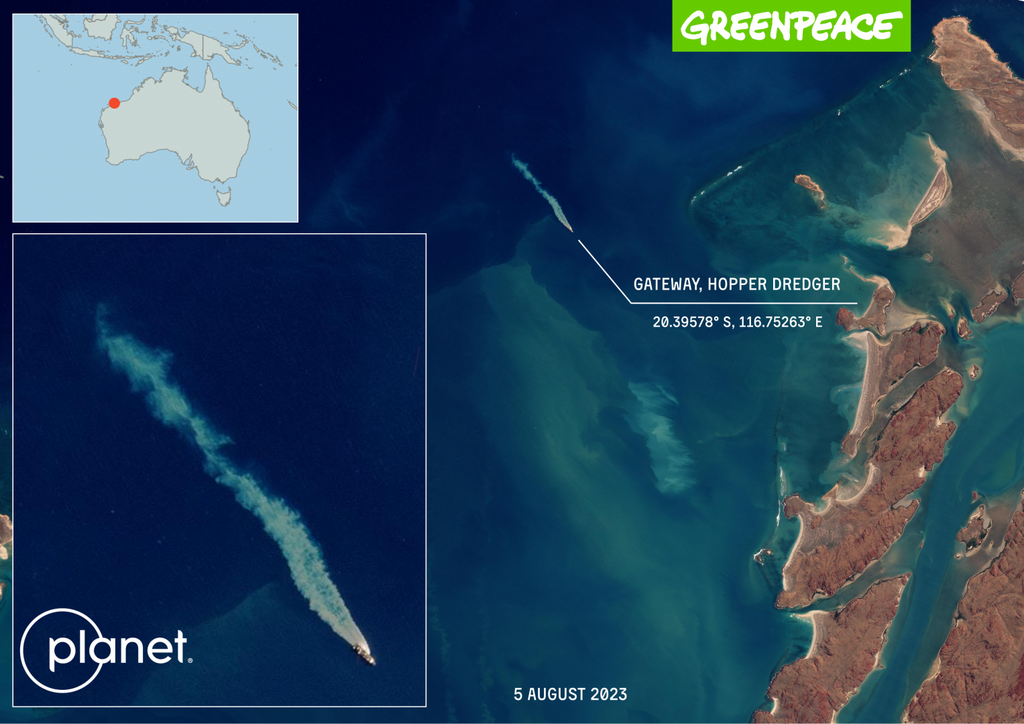Footage of fossil fuel company Woodside dredging in endangered sea turtle habitat shows the company is a ‘clear and present danger’ to our oceans, says environmental group Greenpeace Australia Pacific.

Greenpeace investigators used drones and satellite images to film and photograph Woodside dredging in the Dampier Archipelago, off the Pilbara coast in northern Western Australia. The area is a critical breeding habitat for sea turtles, including endangered hawksbill turtles and green turtles. Footage taken by Greenpeace shows turtle nests on Conzinc Island just metres from where Woodside is dredging.

Just last week the fossil fuel company’s controversial plan for seismic blasting in endangered whale habitat was approved by the offshore regulator NOPSEMA. It’s the first major environmental plan to be approved by the regulator since the Tiwi Islands Federal Court case earlier in the year.
Woodside plans to seismic blast for up to 80 days off the Pilbara coast to assess gas reserves for its Burrup Hub, which if it goes ahead will be Australia’s dirtiest fossil fuel project.
Greenpeace has vowed to escalate pressure on the company.
Greenpeace Australia Pacific senior campaigner Richard George said that Woodside’s Burrup Hub is an ecological disaster and is already getting significant backlash from the community.
“Woodside’s Burrup Hub is a disaster for nature and the climate. We will be fighting it every step of the way and ensure the world is watching Woodside’s wanton destruction of our environment,” he said.
“Right now, Woodside is dredging the seafloor in the beautiful Dampier Archipelago, creating a plume of destruction so big it can be seen from space. Woodside’s dredging is disturbing fragile marine ecosystems and posing a direct threat to baby sea turtles. It’s an environmental disaster that should have never been allowed to go ahead.
“Woodside also has the green light to seismic blast in whale habitat, close to an endangered pygmy blue whale migration superhighway and UNESCO-protected Ningaloo Reef. Seismic blasting can deafen whales, who use their sonar to find food – so a deaf whale is a dead whale.
“You would think the awful pictures of pilot whales beaching in southern WA would have reminded Woodside how vulnerable whales are to changes in their environment.
“Woodside’s vision for the region includes running a pipeline right past diving paradise Rowley Shoals, and drilling all around Scott Reef, one of Australia’s most pristine coral reefs. All in order to export climate-wrecking gas that will bring us more bushfires, drought and floods.
“Australians want green jobs and healthy oceans, not Woodside’s dirty gas. Every day more and more people are taking action to stand up for our oceans and climate. Woodside’s greedy executives should brace for community outrage. We’re calling on Australia’s federal leaders and regulators to reject Woodside’s further plans and stop this dirty project in its tracks.
—ENDS—
Images and footage of Woodside’s dredging activity in Dampier Archipelago, activists on site and footage of humpback whales and turtles in the area can be found in the Greenpeace Media Library
Key facts about Woodside’s Burrup Hub pipeline
- The overall Scarborough pipeline would run approximately 435km from the Pluto LNG onshore gas processing plant to the offshore Scarborough gas field. About 400km of the pipeline is in Commonwealth waters.
- The pipeline would run through Mermaid Sound in the Dampier Archipelago and Montebello Marine Park. Several of the islands in the Dampier Archipelago are nature reserves.
- The nearshore section of the pipeline (from the shore to about the 50km offshore mark) will be laid by first dredging a trench and dumping the dredged material at some specified nearby sites (the ‘spoil grounds’). The pipeline will be laid inside the trench. The trench is then backfilled using spoils from the trench or sand which will be dredged and transported from a nearby ‘borrow ground’.
- Up to 2.7 million cubic metres of material will be dredged out of the pipeline route in both state and commonwealth waters.
- Up to 2 million cubic metres of sand will be dredged and taken from the commonwealth borrow ground. The commonwealth borrow ground is an area of about 17km2 that is only 250m from the boundary of the Dampier Marine Park.
- The state waters section of the pipeline is expected to take about 18 months in total to complete. The commonwealth waters section is expected to take about 24 months to complete. It is unclear if there will be overlaps in these timings.
Nature impacts
- Mermaid Sound is a critical nesting and internesting habitat for Green Turtles (Endangered) and Hawksbill Turtles (Critically Endangered), a mating, nesting and internesting habitat for Flatback Turtles (Data Deficient) and an internesting habitat for Loggerhead Turtles (Vulnerable). Note that these are the species status as per the IUCN Red List.
- Montebello Marine Park is an internesting habitat for Green Turtles, Flatback Turtles, Hawksbill Turtles and Loggerhead Turtles, which nest on nearby Montebello Islands.
- According to Woodside, the pipeline is likely to affect nine species of whale, including pygmy blue whales, sei whales, fin whales, southern right whales, humpback whales and Antarctic minke whales.
- According to Woodside, the pipeline is likely to affect whale sharks, grey nurse sharks, oceanic whitetip sharks, white sharks, shortfin and longfin mako sharks, reef manta rays and giant manta rays, and various species of sawfish.
